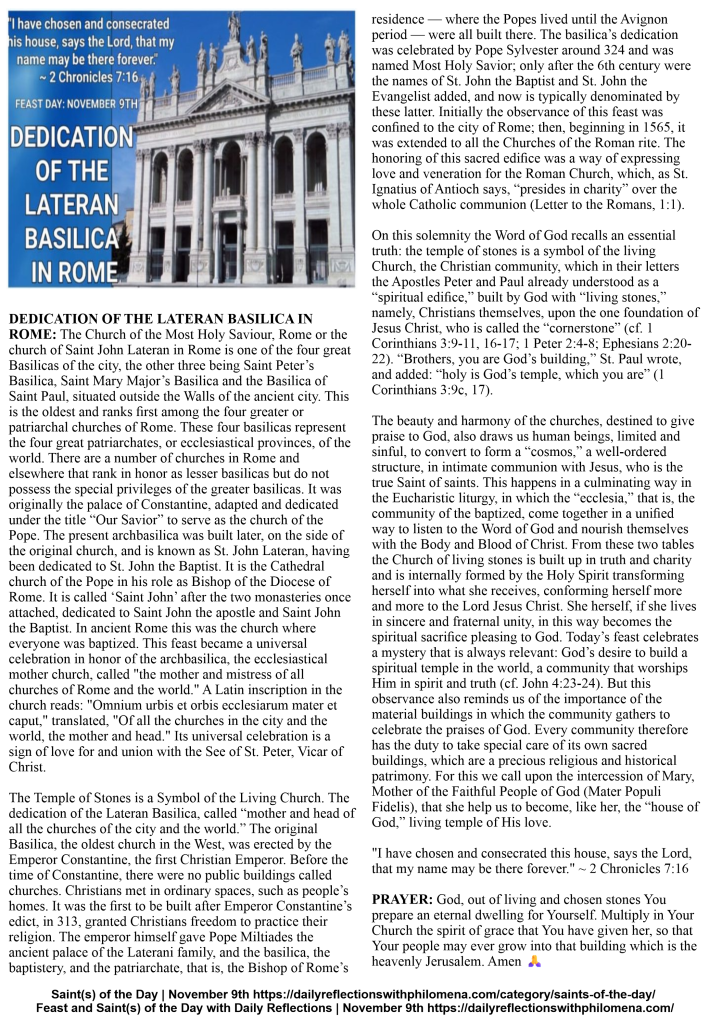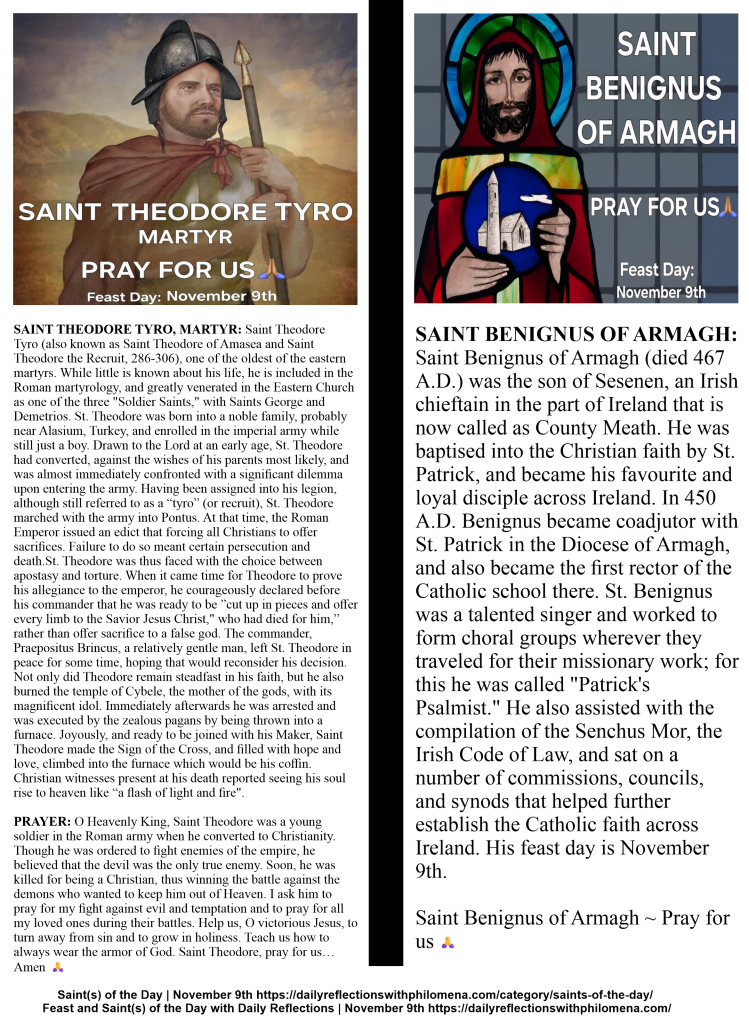

FEAST OF THE DEDICATION OF THE LATERAN BASILICA IN ROME | MEMORIAL OF SAINT THEODORE TYRO, MARTYR AND SAINT BENIGNUS OF ARMAGH – FEAST DAY ~ NOVEMBER 9TH: Today, we celebrate the Feast of the Dedication of the Lateran Basilica in Rome (The Church of the Most Holy Saviour, Rome) and the Memorial of Saint Theodore Tyro, Martyr in Asia Minor and Saint Benignus of Armagh.
DEDICATION OF THE LATERAN BASILICA IN ROME: The Church of the Most Holy Saviour, Rome or the church of Saint John Lateran in Rome is one of the four great Basilicas of the city, the other three being Saint Peter’s Basilica, Saint Mary Major’s Basilica and the Basilica of Saint Paul, situated outside the Walls of the ancient city. This is the oldest and ranks first among the four greater or patriarchal churches of Rome. These four basilicas represent the four great patriarchates, or ecclesiastical provinces, of the world. There are a number of churches in Rome and elsewhere that rank in honor as lesser basilicas but do not possess the special privileges of the greater basilicas. It was originally the palace of Constantine, adapted and dedicated under the title “Our Savior” to serve as the church of the Pope. The present archbasilica was built later, on the side of the original church, and is known as St. John Lateran, having been dedicated to St. John the Baptist. It is the Cathedral church of the Pope in his role as Bishop of the Diocese of Rome. It is called ‘Saint John’ after the two monasteries once attached, dedicated to Saint John the apostle and Saint John the Baptist. In ancient Rome this was the church where everyone was baptized. This feast became a universal celebration in honor of the archbasilica, the ecclesiastical mother church, called “the mother and mistress of all churches of Rome and the world.” A Latin inscription in the church reads: “Omnium urbis et orbis ecclesiarum mater et caput,” translated, “Of all the churches in the city and the world, the mother and head.” Its universal celebration is a sign of love for and union with the See of St. Peter, Vicar of Christ.
The Temple of Stones is a Symbol of the Living Church. The dedication of the Lateran Basilica, called “mother and head of all the churches of the city and the world.” The original Basilica, the oldest church in the West, was erected by the Emperor Constantine, the first Christian Emperor. Before the time of Constantine, there were no public buildings called churches. Christians met in ordinary spaces, such as people’s homes. It was the first to be built after Emperor Constantine’s edict, in 313, granted Christians freedom to practice their religion. The emperor himself gave Pope Miltiades the ancient palace of the Laterani family, and the basilica, the baptistery, and the patriarchate, that is, the Bishop of Rome’s residence — where the Popes lived until the Avignon period — were all built there. The basilica’s dedication was celebrated by Pope Sylvester around 324 and was named Most Holy Savior; only after the 6th century were the names of St. John the Baptist and St. John the Evangelist added, and now is typically denominated by these latter. Initially the observance of this feast was confined to the city of Rome; then, beginning in 1565, it was extended to all the Churches of the Roman rite. The honoring of this sacred edifice was a way of expressing love and veneration for the Roman Church, which, as St. Ignatius of Antioch says, “presides in charity” over the whole Catholic communion (Letter to the Romans, 1:1).
On this solemnity the Word of God recalls an essential truth: the temple of stones is a symbol of the living Church, the Christian community, which in their letters the Apostles Peter and Paul already understood as a “spiritual edifice,” built by God with “living stones,” namely, Christians themselves, upon the one foundation of Jesus Christ, who is called the “cornerstone” (cf. 1 Corinthians 3:9-11, 16-17; 1 Peter 2:4-8; Ephesians 2:20-22). “Brothers, you are God’s building,” St. Paul wrote, and added: “holy is God’s temple, which you are” (1 Corinthians 3:9c, 17).
The beauty and harmony of the churches, destined to give praise to God, also draws us human beings, limited and sinful, to convert to form a “cosmos,” a well-ordered structure, in intimate communion with Jesus, who is the true Saint of saints. This happens in a culminating way in the Eucharistic liturgy, in which the “ecclesia,” that is, the community of the baptized, come together in a unified way to listen to the Word of God and nourish themselves with the Body and Blood of Christ. From these two tables the Church of living stones is built up in truth and charity and is internally formed by the Holy Spirit transforming herself into what she receives, conforming herself more and more to the Lord Jesus Christ. She herself, if she lives in sincere and fraternal unity, in this way becomes the spiritual sacrifice pleasing to God. Today’s feast celebrates a mystery that is always relevant: God’s desire to build a spiritual temple in the world, a community that worships Him in spirit and truth (cf. John 4:23-24). But this observance also reminds us of the importance of the material buildings in which the community gathers to celebrate the praises of God. Every community therefore has the duty to take special care of its own sacred buildings, which are a precious religious and historical patrimony. For this we call upon the intercession of Mary, Mother of the Faithful People of God (Mater Populi Fidelis), that she help us to become, like her, the “house of God,” living temple of His love.
“I have chosen and consecrated this house, says the Lord, that my name may be there forever.” ~ 2 Chronicles 7:16
PRAYER: God, out of living and chosen stones You prepare an eternal dwelling for Yourself. Multiply in Your Church the spirit of grace that You have given her, so that Your people may ever grow into that building which is the heavenly Jerusalem. Amen 🙏
SAINT THEODORE TYRO, MARTYR: Saint Theodore Tyro (also known as Saint Theodore of Amasea and Saint Theodore the Recruit, 286-306), one of the oldest of the eastern martyrs. While little is known about his life, he is included in the Roman martyrology, and greatly venerated in the Eastern Church as one of the three “Soldier Saints,” with Saints George and Demetrios. St. Theodore was born into a noble family, probably near Alasium, Turkey, and enrolled in the imperial army while still just a boy. Drawn to the Lord at an early age, St. Theodore had converted, against the wishes of his parents most likely, and was almost immediately confronted with a significant dilemma upon entering the army. Having been assigned into his legion, although still referred to as a “tyro” (or recruit), St. Theodore marched with the army into Pontus. At that time, the Roman Emperor issued an edict that forcing all Christians to offer sacrifices. Failure to do so meant certain persecution and death.
St. Theodore was thus faced with the choice between apostasy and torture. When it came time for Theodore to prove his allegiance to the emperor, he courageously declared before his commander that he was ready to be ”cut up in pieces and offer every limb to the Savior Jesus Christ,” who had died for him,” rather than offer sacrifice to a false god. The commander, Praepositus Brincus, a relatively gentle man, left St. Theodore in peace for some time, hoping that would reconsider his decision. Not only did Theodore remain steadfast in his faith, but he also burned the temple of Cybele, the mother of the gods, with its magnificent idol. Immediately afterwards he was arrested and was executed by the zealous pagans by being thrown into a furnace. Joyously, and ready to be joined with his Maker, Saint Theodore made the Sign of the Cross, and filled with hope and love, climbed into the furnace which would be his coffin. Christian witnesses present at his death reported seeing his soul rise to heaven like “a flash of light and fire”.
PRAYER: O Heavenly King, Saint Theodore was a young soldier in the Roman army when he converted to Christianity. Though he was ordered to fight enemies of the empire, he believed that the devil was the only true enemy. Soon, he was killed for being a Christian, thus winning the battle against the demons who wanted to keep him out of Heaven. I ask him to pray for my fight against evil and temptation and to pray for all my loved ones during their battles. Help us, O victorious Jesus, to turn away from sin and to grow in holiness. Teach us how to always wear the armor of God. Saint Theodore, pray for us… Amen.🙏
SAINT BENIGNUS OF ARMAGH: Saint Benignus of Armagh (died 467 A.D.) was the son of Sesenen, an Irish chieftain in the part of Ireland that is now called as County Meath. He was baptised into the Christian faith by St. Patrick, and became his favourite and loyal disciple across Ireland. In 450 A.D. Benignus became coadjutor with St. Patrick in the Diocese of Armagh, and also became the first rector of the Catholic school there. St. Benignus was a talented singer and worked to form choral groups wherever they traveled for their missionary work; for this he was called “Patrick’s Psalmist.” He also assisted with the compilation of the Senchus Mor, the Irish Code of Law, and sat on a number of commissions, councils, and synods that helped further establish the Catholic faith across Ireland. His feast day is November 9th.
Saint Benignus of Armagh ~ Pray for us 🙏